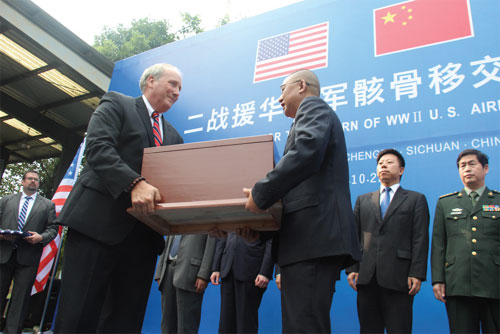Flying Tigers' remains heading home at last
|
Fan Jianchuan, curator of the Jianchuan Museum Cluster, presents the remains of United States airmen found in Tibet to James Darby, senior policy adviser to the US Defence Personnel Accounting Agency, in Sichuan province on Thursday. Huang Zhiling / China Daily |
A solemn ceremony held in Sichuan province on Thursday honored the return of the remains of United States airmen who flew during World War II.
Held at the Jianchuan Museum Cluster in Anren, a town in Dayi county, the ceremony lasted just 30 minutes, but marked the start of a return journey home for three airmen after more than 70 years.
The remains, believed to be those of three men, comprise 28 bones - including a complete skeleton's foot - and an airman's boot.
They were found either in or near a US transport plane with the serial number 4124688 that went down while flying over the eastern Himalayas in the winter of 1943.
The plane, which crashed on the Ruoguo Glacier in Nyingchi, Tibet, was found by Luo Song, a local hunter, 4,100 meters above sea level in September 1993.
Although the remains of five airmen recovered from the crash site were handed over to the US in 1999, most parts of the plane were left at the scene as they were hard to reach.
Six years ago, Fan Jianchuan, curator of the Jianchuan Museum Cluster, heard from a fellow ex-serviceman of the plane's location in Tibet.
"I told myself I would bring it to my museum," said Fan, who owns the country's largest private museum. It has a hall-the Flying Tigers Hall- named in honor of the American Volunteer Group formed in 1941 to help China drive out invading Japanese troops.
Organized by the museum, a motorcade set out for Tibet on Aug 5.
"Because of transportation difficulties, only about 50 pieces of the plane's remains were brought to the museum on Aug 14," Fan said. Searchers also found the 28 bones.
Raymond Greene, consul general at the US Consulate in Chengdu, said the US would try to identify the remains and inform the relatives.
Between 1942 and 1945, weapons and cargo were transported from India to Yunnan by the air route over the Himalayas known as the "Hump".
huangzhiling@ chinadaily.com.cn



















